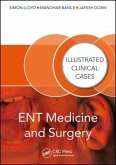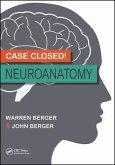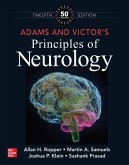Handbook of Neurosurgery, Neurology, and Spinal Medicine for Nurses and Advanced Practice Health Professionals
Herausgeber: Strayer, Andrea; Mummaneni, Praveen; Harris, Odette; Wang, Michael; Rosenberg, Cathy
Handbook of Neurosurgery, Neurology, and Spinal Medicine for Nurses and Advanced Practice Health Professionals
Herausgeber: Strayer, Andrea; Mummaneni, Praveen; Harris, Odette; Wang, Michael; Rosenberg, Cathy
- Broschiertes Buch
- Merkliste
- Auf die Merkliste
- Bewerten Bewerten
- Teilen
- Produkt teilen
- Produkterinnerung
- Produkterinnerung
This practical handbook allows nurses, physician assistants, and allied health professionals practicing in the fields of neurosurgery, neurology, and spinal care to quickly review essentials while in the work environment. It emphasizes procedural steps and critical elements in patient management. Written by a multidisciplinary team of experts.
Andere Kunden interessierten sich auch für
![ENT Medicine and Surgery ENT Medicine and Surgery]() ENT Medicine and Surgery44,99 €
ENT Medicine and Surgery44,99 €![Case Closed! Neuroanatomy Case Closed! Neuroanatomy]() Warren Berger (BSc BESc MD, Senior Neurology Resident, Schulich SchCase Closed! Neuroanatomy55,99 €
Warren Berger (BSc BESc MD, Senior Neurology Resident, Schulich SchCase Closed! Neuroanatomy55,99 €![Trounce's Clinical Pharmacology for Nurses and Allied Health Professionals Trounce's Clinical Pharmacology for Nurses and Allied Health Professionals]() Clive P. Page (Sackler Institute of Pulmonary Pharmacolog DirectorTrounce's Clinical Pharmacology for Nurses and Allied Health Professionals46,99 €
Clive P. Page (Sackler Institute of Pulmonary Pharmacolog DirectorTrounce's Clinical Pharmacology for Nurses and Allied Health Professionals46,99 €![Psychology for Nurses and Health Professionals Psychology for Nurses and Health Professionals]() Richard GrossPsychology for Nurses and Health Professionals61,99 €
Richard GrossPsychology for Nurses and Health Professionals61,99 €![Oxford Handbook of Prescribing for Nurses and Allied Health Professionals Oxford Handbook of Prescribing for Nurses and Allied Health Professionals]() Sue Beckwith (Doctoral Research Consortium for Healthcare ResearchOxford Handbook of Prescribing for Nurses and Allied Health Professionals45,99 €
Sue Beckwith (Doctoral Research Consortium for Healthcare ResearchOxford Handbook of Prescribing for Nurses and Allied Health Professionals45,99 €![Adams and Victor's Principles of Neurology, Twelfth Edition Adams and Victor's Principles of Neurology, Twelfth Edition]() Allan RopperAdams and Victor's Principles of Neurology, Twelfth Edition224,99 €
Allan RopperAdams and Victor's Principles of Neurology, Twelfth Edition224,99 €![Health Policy: Applications for Nurses and Other Healthcare Professionals Health Policy: Applications for Nurses and Other Healthcare Professionals]() Demetrius J PorcheHealth Policy: Applications for Nurses and Other Healthcare Professionals139,99 €
Demetrius J PorcheHealth Policy: Applications for Nurses and Other Healthcare Professionals139,99 €-
-
-
This practical handbook allows nurses, physician assistants, and allied health professionals practicing in the fields of neurosurgery, neurology, and spinal care to quickly review essentials while in the work environment. It emphasizes procedural steps and critical elements in patient management. Written by a multidisciplinary team of experts.
Hinweis: Dieser Artikel kann nur an eine deutsche Lieferadresse ausgeliefert werden.
Hinweis: Dieser Artikel kann nur an eine deutsche Lieferadresse ausgeliefert werden.
Produktdetails
- Produktdetails
- Verlag: Taylor & Francis Inc
- Seitenzahl: 576
- Erscheinungstermin: 20. Dezember 2017
- Englisch
- Abmessung: 191mm x 247mm x 37mm
- Gewicht: 1236g
- ISBN-13: 9781498719421
- ISBN-10: 1498719422
- Artikelnr.: 50747849
- Herstellerkennzeichnung
- Libri GmbH
- Europaallee 1
- 36244 Bad Hersfeld
- gpsr@libri.de
- Verlag: Taylor & Francis Inc
- Seitenzahl: 576
- Erscheinungstermin: 20. Dezember 2017
- Englisch
- Abmessung: 191mm x 247mm x 37mm
- Gewicht: 1236g
- ISBN-13: 9781498719421
- ISBN-10: 1498719422
- Artikelnr.: 50747849
- Herstellerkennzeichnung
- Libri GmbH
- Europaallee 1
- 36244 Bad Hersfeld
- gpsr@libri.de
Michael Wang, is a Professor in the Departments of Neurosurgery & Rehabilitation Medicine at the University of Miami Miller School of Medicine, Miami, Florida, USA. Odette Harris, is an associate professor at Stanford University, Stanford, California, USA. Andrea Strayer, is a certified Adult and Geriatric Nurse Practitioner in the Department of Neurosurgery, School of Medicine and Public Health at the University of Wisconsin-Madison, Wisconsin, USA. Cathy Rosenberg, is a Clinical Instructor and Certified Acute Care Nurse Practitioner in the Department of Neurological Surgery at tje University of Miami Miller School of Medicine, Miami, Florida, USA. Praveen Mummaneni, is Joan O'Reilly Endowed Professor at the University of California, San Francisco, USA.
Part I: Introduction.
1. The importance of neurological illnesses. emergencies. and treatments
2. Neurological decompensation and emergencies
3. The Neurointensive Care and Neuromonitoring Unit
4. The Neurosurgical Operating Room
5. Neurological Triage and the Differential Diagnosis
Part II: Anatomy.
6. Neuroanatomy overview Part I: Cranial
7. Neuroanatomy overview Part II: Spine
8. Neuroanatomy Overview Part III: Peripheral Nervous System
9. The neurological examination Part I: Cranial
10. The neurological examination Part II: Spine
11. The Neurological Examination Part III: Peripheral Nervous System
12. Lesion Localization
13. The neurological examination of the infant and child
Part III: The team approach.
14. Collaborative Practice with the Neurointensivist. Neurologist. and
Neurosurgeon
15. Occupational. physical and speech therapies
16. Neuroanesthesia
17. Nutrition and Surgical Recovery
18. Social Services & Case Management
19. Coordinating and Preparing for the Transition from the Acute Care
Setting
20. Adaptive Equipment
21. Short and Long Term Disability
22. Scientific Research & Clinical Trials
Part IV: Monitoring the patient.
23. Serial Neurologic Examinations
24. Intracranial Pressure Management
25. Electrophysiology
26. Monitoring the Patient: CSF Drainage
27. Spine Surgery Wound and Drain Management
28. Neurological Monitoring
29. The Post Anesthesia Care Unit (PACU) Environment and the Neurosurgical
Patient
Part V: Clinical pathologies and scenarios: Brain.
30. Mild Traumatic Brain Injury
31. Severe Traumatic Brain Injury
32. Chronic Subdural Hematoma management
33. Acute Hemorrhagic Stroke
34. Clinical Pathologies and Scenarios: Subarachnoid Hemorrhage
35. Hydrocephalus
36. Malignant Brain Neoplasms and Brain Metastasis
37. Pituitary Surgery
38. Skull base tumors
39. Posterior Fossa Surgery
40. Epilepsy Surgery
41. Brain Abscess
42. Type I Chiari Malformations
43. Brain Death and Organ Donation
Part VI: Clinical pathologies and scenarios: Spine.
44. Spinal Cord Injuries and Fractures
45. Cauda Equina Syndrome
46. Acute Low Back Pain
47. Acute Neck Pain & Whiplash
48. Anterior cervical surgery
49. Posterior Cervical Surgery
50. Spinal Decompressive Surgeries and Lumbar Microdiscectomy
51. ELECTIVE SPINAL SURGERY FOR LUMBAR FUSION
52. Elective Spinal Surgery for Scoliosis & Kyphosis
53. Spinal Tumors
54. Postoperative Multimodal Oral Pain Management in the Spine Patient
55. Bracing and Electrical Stimulation
56. Postoperative Physical and Occupational Therapy
57. Community-Acquired Spinal Infections
58. Iatrogenic Spinal Infections
59. Clinical Pathologies and Scenarios: Spinal Fluid Leakage
60. Percutaneous Spinal Interventions & Pain Management
Part VII: Clinical pathologies and scenarios: Neurology.
61. Acute Ischemic Stroke
62. Delirium
63. Meningitis
64. Alzheimer's dementia
65. Parkinson Disease
66. Status Epilepticus
67. DEMYELINATING SYNDROME: Multiple Sclerosis
68. Intoxications
69. Headache
70. Peripheral Nerve Disorders
1. The importance of neurological illnesses. emergencies. and treatments
2. Neurological decompensation and emergencies
3. The Neurointensive Care and Neuromonitoring Unit
4. The Neurosurgical Operating Room
5. Neurological Triage and the Differential Diagnosis
Part II: Anatomy.
6. Neuroanatomy overview Part I: Cranial
7. Neuroanatomy overview Part II: Spine
8. Neuroanatomy Overview Part III: Peripheral Nervous System
9. The neurological examination Part I: Cranial
10. The neurological examination Part II: Spine
11. The Neurological Examination Part III: Peripheral Nervous System
12. Lesion Localization
13. The neurological examination of the infant and child
Part III: The team approach.
14. Collaborative Practice with the Neurointensivist. Neurologist. and
Neurosurgeon
15. Occupational. physical and speech therapies
16. Neuroanesthesia
17. Nutrition and Surgical Recovery
18. Social Services & Case Management
19. Coordinating and Preparing for the Transition from the Acute Care
Setting
20. Adaptive Equipment
21. Short and Long Term Disability
22. Scientific Research & Clinical Trials
Part IV: Monitoring the patient.
23. Serial Neurologic Examinations
24. Intracranial Pressure Management
25. Electrophysiology
26. Monitoring the Patient: CSF Drainage
27. Spine Surgery Wound and Drain Management
28. Neurological Monitoring
29. The Post Anesthesia Care Unit (PACU) Environment and the Neurosurgical
Patient
Part V: Clinical pathologies and scenarios: Brain.
30. Mild Traumatic Brain Injury
31. Severe Traumatic Brain Injury
32. Chronic Subdural Hematoma management
33. Acute Hemorrhagic Stroke
34. Clinical Pathologies and Scenarios: Subarachnoid Hemorrhage
35. Hydrocephalus
36. Malignant Brain Neoplasms and Brain Metastasis
37. Pituitary Surgery
38. Skull base tumors
39. Posterior Fossa Surgery
40. Epilepsy Surgery
41. Brain Abscess
42. Type I Chiari Malformations
43. Brain Death and Organ Donation
Part VI: Clinical pathologies and scenarios: Spine.
44. Spinal Cord Injuries and Fractures
45. Cauda Equina Syndrome
46. Acute Low Back Pain
47. Acute Neck Pain & Whiplash
48. Anterior cervical surgery
49. Posterior Cervical Surgery
50. Spinal Decompressive Surgeries and Lumbar Microdiscectomy
51. ELECTIVE SPINAL SURGERY FOR LUMBAR FUSION
52. Elective Spinal Surgery for Scoliosis & Kyphosis
53. Spinal Tumors
54. Postoperative Multimodal Oral Pain Management in the Spine Patient
55. Bracing and Electrical Stimulation
56. Postoperative Physical and Occupational Therapy
57. Community-Acquired Spinal Infections
58. Iatrogenic Spinal Infections
59. Clinical Pathologies and Scenarios: Spinal Fluid Leakage
60. Percutaneous Spinal Interventions & Pain Management
Part VII: Clinical pathologies and scenarios: Neurology.
61. Acute Ischemic Stroke
62. Delirium
63. Meningitis
64. Alzheimer's dementia
65. Parkinson Disease
66. Status Epilepticus
67. DEMYELINATING SYNDROME: Multiple Sclerosis
68. Intoxications
69. Headache
70. Peripheral Nerve Disorders
Part I: Introduction.
1. The importance of neurological illnesses. emergencies. and treatments
2. Neurological decompensation and emergencies
3. The Neurointensive Care and Neuromonitoring Unit
4. The Neurosurgical Operating Room
5. Neurological Triage and the Differential Diagnosis
Part II: Anatomy.
6. Neuroanatomy overview Part I: Cranial
7. Neuroanatomy overview Part II: Spine
8. Neuroanatomy Overview Part III: Peripheral Nervous System
9. The neurological examination Part I: Cranial
10. The neurological examination Part II: Spine
11. The Neurological Examination Part III: Peripheral Nervous System
12. Lesion Localization
13. The neurological examination of the infant and child
Part III: The team approach.
14. Collaborative Practice with the Neurointensivist. Neurologist. and
Neurosurgeon
15. Occupational. physical and speech therapies
16. Neuroanesthesia
17. Nutrition and Surgical Recovery
18. Social Services & Case Management
19. Coordinating and Preparing for the Transition from the Acute Care
Setting
20. Adaptive Equipment
21. Short and Long Term Disability
22. Scientific Research & Clinical Trials
Part IV: Monitoring the patient.
23. Serial Neurologic Examinations
24. Intracranial Pressure Management
25. Electrophysiology
26. Monitoring the Patient: CSF Drainage
27. Spine Surgery Wound and Drain Management
28. Neurological Monitoring
29. The Post Anesthesia Care Unit (PACU) Environment and the Neurosurgical
Patient
Part V: Clinical pathologies and scenarios: Brain.
30. Mild Traumatic Brain Injury
31. Severe Traumatic Brain Injury
32. Chronic Subdural Hematoma management
33. Acute Hemorrhagic Stroke
34. Clinical Pathologies and Scenarios: Subarachnoid Hemorrhage
35. Hydrocephalus
36. Malignant Brain Neoplasms and Brain Metastasis
37. Pituitary Surgery
38. Skull base tumors
39. Posterior Fossa Surgery
40. Epilepsy Surgery
41. Brain Abscess
42. Type I Chiari Malformations
43. Brain Death and Organ Donation
Part VI: Clinical pathologies and scenarios: Spine.
44. Spinal Cord Injuries and Fractures
45. Cauda Equina Syndrome
46. Acute Low Back Pain
47. Acute Neck Pain & Whiplash
48. Anterior cervical surgery
49. Posterior Cervical Surgery
50. Spinal Decompressive Surgeries and Lumbar Microdiscectomy
51. ELECTIVE SPINAL SURGERY FOR LUMBAR FUSION
52. Elective Spinal Surgery for Scoliosis & Kyphosis
53. Spinal Tumors
54. Postoperative Multimodal Oral Pain Management in the Spine Patient
55. Bracing and Electrical Stimulation
56. Postoperative Physical and Occupational Therapy
57. Community-Acquired Spinal Infections
58. Iatrogenic Spinal Infections
59. Clinical Pathologies and Scenarios: Spinal Fluid Leakage
60. Percutaneous Spinal Interventions & Pain Management
Part VII: Clinical pathologies and scenarios: Neurology.
61. Acute Ischemic Stroke
62. Delirium
63. Meningitis
64. Alzheimer's dementia
65. Parkinson Disease
66. Status Epilepticus
67. DEMYELINATING SYNDROME: Multiple Sclerosis
68. Intoxications
69. Headache
70. Peripheral Nerve Disorders
1. The importance of neurological illnesses. emergencies. and treatments
2. Neurological decompensation and emergencies
3. The Neurointensive Care and Neuromonitoring Unit
4. The Neurosurgical Operating Room
5. Neurological Triage and the Differential Diagnosis
Part II: Anatomy.
6. Neuroanatomy overview Part I: Cranial
7. Neuroanatomy overview Part II: Spine
8. Neuroanatomy Overview Part III: Peripheral Nervous System
9. The neurological examination Part I: Cranial
10. The neurological examination Part II: Spine
11. The Neurological Examination Part III: Peripheral Nervous System
12. Lesion Localization
13. The neurological examination of the infant and child
Part III: The team approach.
14. Collaborative Practice with the Neurointensivist. Neurologist. and
Neurosurgeon
15. Occupational. physical and speech therapies
16. Neuroanesthesia
17. Nutrition and Surgical Recovery
18. Social Services & Case Management
19. Coordinating and Preparing for the Transition from the Acute Care
Setting
20. Adaptive Equipment
21. Short and Long Term Disability
22. Scientific Research & Clinical Trials
Part IV: Monitoring the patient.
23. Serial Neurologic Examinations
24. Intracranial Pressure Management
25. Electrophysiology
26. Monitoring the Patient: CSF Drainage
27. Spine Surgery Wound and Drain Management
28. Neurological Monitoring
29. The Post Anesthesia Care Unit (PACU) Environment and the Neurosurgical
Patient
Part V: Clinical pathologies and scenarios: Brain.
30. Mild Traumatic Brain Injury
31. Severe Traumatic Brain Injury
32. Chronic Subdural Hematoma management
33. Acute Hemorrhagic Stroke
34. Clinical Pathologies and Scenarios: Subarachnoid Hemorrhage
35. Hydrocephalus
36. Malignant Brain Neoplasms and Brain Metastasis
37. Pituitary Surgery
38. Skull base tumors
39. Posterior Fossa Surgery
40. Epilepsy Surgery
41. Brain Abscess
42. Type I Chiari Malformations
43. Brain Death and Organ Donation
Part VI: Clinical pathologies and scenarios: Spine.
44. Spinal Cord Injuries and Fractures
45. Cauda Equina Syndrome
46. Acute Low Back Pain
47. Acute Neck Pain & Whiplash
48. Anterior cervical surgery
49. Posterior Cervical Surgery
50. Spinal Decompressive Surgeries and Lumbar Microdiscectomy
51. ELECTIVE SPINAL SURGERY FOR LUMBAR FUSION
52. Elective Spinal Surgery for Scoliosis & Kyphosis
53. Spinal Tumors
54. Postoperative Multimodal Oral Pain Management in the Spine Patient
55. Bracing and Electrical Stimulation
56. Postoperative Physical and Occupational Therapy
57. Community-Acquired Spinal Infections
58. Iatrogenic Spinal Infections
59. Clinical Pathologies and Scenarios: Spinal Fluid Leakage
60. Percutaneous Spinal Interventions & Pain Management
Part VII: Clinical pathologies and scenarios: Neurology.
61. Acute Ischemic Stroke
62. Delirium
63. Meningitis
64. Alzheimer's dementia
65. Parkinson Disease
66. Status Epilepticus
67. DEMYELINATING SYNDROME: Multiple Sclerosis
68. Intoxications
69. Headache
70. Peripheral Nerve Disorders








